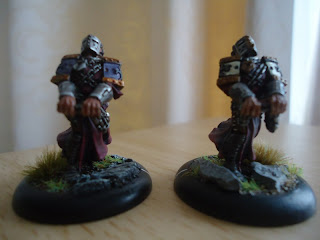Work has progressed apace since I completed the Vassal the other day. Myself, Luke, Andy and Mark are about ready for Golden Troll tomorrow, I've played a heap of practice games and am pretty much all set, just looking forward to the event now. I did take a few photos of the desert terrain all set up, it can be seen at the bottom of this page.
Recently I started work on two additional Choir members to add to the existing minimum unit, bringing it up to a full six members for the afore mentioned 50 point lists. I simply colour matched the two new choir boys to the colour scheme already established. Like all my Menoth so far; white, sanguine, gold and purple – painted using the Faction book technique. The only difference here was the scrolls, each being unique, the two additions were ‘Fire’ and ‘Heresy’. Below are photos of the whole unit (complete):
 |
| Choir of Menoth front |
 |
| Choir of Menoth right |
 |
| Choir of Menoth left |
 |
| Choir of Menoth rear |
I thought I’d continue the tactica idea started in the previous Vassal entry for those who are interested in my thoughts on the Choir.
Tactica Choir of Menoth:
Overall: The Choir is another warjack support role unit. They are relatively cheap in cost for what they do, two points for a minimum unit (4 models) and three for a full size unit (6 models). The Choir has mediocre defensive stats of DEF and ARM 12 meaning if these guys are shot at they’ll likely die. They have a CMD of 8, though they’ll invariably be able to use the Menoth Warcasters’ CMD value given they’ll not be on the front lines very much. They have appalling MAT and only a P&S 6 weapon, but the Choir isn’t in the list for its combat prowess, but rather its ability to sing hymns capable of protecting the Menite Warjacks as well as improving them in combat.
Hymns: These are RNG 3 which is fairly tight when considering Menite warjacks will be surging forwards, luckily the Choir is SPD 6 meaning they can affect a friendly warjack up to 9” away. One good tip is to measure the reach range of the choir member, as you can do this anytime during the units activation, should you be unsure if it is in range to use the hymn; you might well be able to judge 1” proximity better than 3” when it is touch and go. It should be noted that all Choir members must sing the same hymn and a wajack may only be affected once, even if you have multiple Choir units.
Hymn of Battle: Simple really, +2 to attack and damage rolls for one turn. This can make a pillow fisted jack hit above its weight category, not to mention the accuracy increase. This hymn will almost always allow you to buy extra attacks as opposed to spending focus boosting to hit, obviously against high DEF targets you’d still need to boost, but low DEF stuff can be hit reliably by a Battle sung Menite warjack. It should be noted too that this hymn only lasts for one turn, so it has expired by your opponents turn, so it won’t work with free strikes etc.
Hymn of Passage: The warjack can’t be targeted by non-magical ranged attacks for one round. This does work in your opponents turn as it lasts a ‘round’. Great when facing lots of guns that mean to blow holes in your warjacks. Often enemy guns have cheeky special effects such as critical slamming, knock downs etc that will reduce effectiveness, so this hymn can allow you to advance unscathed. Beware however of enemy abilities that grant magical shooting as well as a range of magical guns out there as these will by-pass the defensive hymn. Also be aware that whilst the warjack can’t be targeted, something next to it may well be and could catch the jack in an AoE or spray etc.
Hymn of Shielding: The target friendly warjack can’t be targeted by enemy spells for one round. Similarly to Hymn of Passage, it is defensive in nature preventing enemy spells affecting it. Again any spells with an AoE can still scatter on to shielded warjacks, they just can’t be targeted so placement and awareness of enemy spells and abilities is paramount.
Closing thoughts: The Choir is a staple unit for any Menite force fielding warjacks, so that’s virtually every list. Usually a minimum sized unit will suffice, but if running four plus warjacks then a max unit, or possibly a second min unit is efficient. The enemy will pick off the Choir at any given time, thus reducing the effectiveness of the warjacks, but they’re only a cheap unit and will be hiding at the back of the field where they are more protected one would hope!
I would recommend starting out with the defensive hymns as the jacks approach, which one really depends on what the enemy army has as the greatest threat, be mindful of the short 3" range and avoid running the jacks out of the Choir's range. Once the jacks can engage use Battle to hit really hard, unless the defensive hymns are really important. I use the Choir members not using their special actions to form an intervening model for my warcaster quite often, it reduces assassination vectors, though not something to rely upon of course. I have recently sent the Choir into melee and with some (well a lot) of luck they have killed some enemy infantry, often in the late game you might consider charging them in. No joke but I killed a Kayazy Assassin, one of Boomhowlers troll men and a couple of Dawnguard Sentinels – Go Choir boys!










































